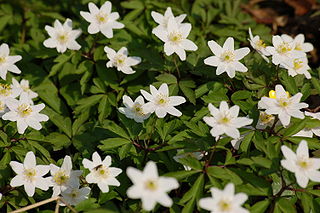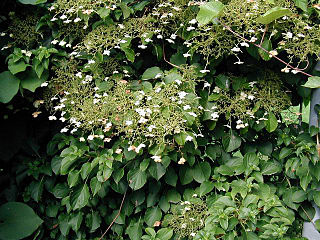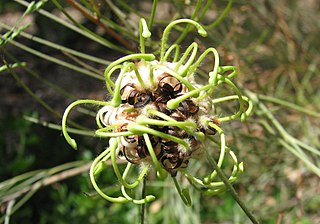
Hydrangea common names hydrangea or hortensia, is a genus of over 75 species of flowering plants native to Asia and the Americas. By far the greatest species diversity is in eastern Asia, notably China, Korea, and Japan. Most are shrubs 1–3 m tall, but some are small trees, and others lianas reaching up to 30 m (100 ft) by climbing up trees. They can be either deciduous or evergreen, though the widely cultivated temperate species are all deciduous.

Anemonoides nemorosa, the wood anemone, is an early-spring flowering plant in the buttercup family Ranunculaceae, native to Europe. Other common names include windflower, European thimbleweed, and smell fox, an allusion to the musky smell of the leaves. It is a perennial herbaceous plant growing 5–15 cm (2–6 in) tall.

Iris macrosiphon, the bowltube iris, is a flowering plant in the iris family, endemic to California in the Cascade Range Foothills, north and central Sierra Nevada Foothills, Inner North Coast Ranges, and San Francisco Bay Area, where it occurs in sunny grasslands, meadows, and open woodlands.

Hydrangea macrophylla is a species of flowering plant in the family Hydrangeaceae, native to Japan. It is a deciduous shrub growing to 2 m (7 ft) tall by 2.5 m (8 ft) broad with large heads of pink or blue flowers in summer and autumn. Common names include bigleaf hydrangea, French hydrangea, lacecap hydrangea, mophead hydrangea, penny mac and hortensia. It is widely cultivated in many parts of the world in many climates. It is not to be confused with H. aspera 'Macrophylla'.

Hydrangea quercifolia, commonly known as oakleaf hydrangea or oak-leaved hydrangea, is a species of flowering plant in the family Hydrangeaceae. It is native to the southeastern United States, in woodland habitats from North Carolina west to Tennessee, and south to Florida and Louisiana. A deciduous shrub with white showy flower heads, it is grown as a garden plant, with numerous cultivars available commercially.

Hydrangea anomala, the Japanese climbing-hydrangea, is a species of flowering plant in the family Hydrangeaceae native to the woodlands of the Himalaya, southern and central China and northern Myanmar.

Hydrangea petiolaris, a climbing hydrangea, is a species of flowering plant in the family Hydrangeaceae native to the woodlands of Japan, the Korean peninsula, and on Sakhalin island of easternmost Siberia in the Russian Far East.

Hydrangea arborescens, commonly known as smooth hydrangea, wild hydrangea, sevenbark, or in some cases, sheep flower, is a species of flowering plant in the family Hydrangeaceae. It is a small- to medium-sized, deciduous shrub up to 3 m (10 ft) tall that is native to the eastern United States.
Banksia biterax is a species of dense shrub that is endemic to Western Australia. It has hairy stems, deeply serrated leaves and spikes of up to 200 pale to dark brown flowers.

Plumbago auriculata, the cape leadwort, blue plumbago or Cape plumbago, is a species of flowering plant in the family Plumbaginaceae, native to South Africa.

Hydrangea aspera is a species of flowering plant in the family Hydrangeaceae, native to the region between the Himalayas, across southern China, to Taiwan. It is a large, erect deciduous shrub growing to 3 m (10 ft) tall and wide, with broadly oval leaves. The flowers are typically borne in large flat heads in late summer, and are in variable shades of pale blue and pink, fringed by white or pale pink sterile florets.

Sisyrinchium idahoense, the Idaho blue-eyed grass, is a perennial that is native to western North America. It is not a true grass, but is instead in the family Iridaceae.

Hydrangea serrata is a species of flowering plant in the family Hydrangeaceae, native to mountainous regions of Korea and Japan. Common names include mountain hydrangea and tea of heaven. Growing to 1.2 m (4 ft) tall and broad, it is a deciduous shrub with oval leaves and panicles of blue and pink flowers in summer and autumn (fall). It is widely cultivated as an attractive ornamental shrub throughout the world in areas with suitable climate and soil.

Hydrangea paniculata, the panicled hydrangea or limelight hydrangea, is a species of flowering plant in the family Hydrangeaceae native to southern and eastern China, Korea, Japan and Russia (Sakhalin). It was first formally described by Philipp Franz von Siebold in 1829.

Hydrangea hirta, also known as the "nettle-leaved hydrangea", is a species of flowering plant in the family Hydrangeaceae that is native to East Asia. Due to the beauty and sturdiness of the species' flowers it can be found outside of its range being used for horticultural and landscaping purposes, and is found in gardens in countries including the United Kingdom and the United States.

Grevillea globosa is a species of flowering plant in the family Proteaceae and is endemic to the south-west of Western Australia. It is a spreading shrub with deeply divided leaves that have three to nine linear lobes, and dense, spherical clusters of pale green, creamy-green and reddish-brown flowers.

Hakea propinqua is a flowering shrub in the family Proteaceae. It is a common shrub found in heathlands near Sydney. It has sharp, needle-shaped leaves, white unpleasantly scented flowers and large warty fruit.

Grevillea latifolia is a species of flowering plant in the family Proteaceae and is endemic to the Kimberley region of Western Australia. It is a shrub with round or broadly egg-shaped to heart-shaped leaves with the narrower end towards the base, and clusters of pale to deep flowers that turn red as they age.

Grevillea leiophylla, commonly known as wallum grevillea, or dwarf spider oak, is a species of flowering plant in the family Proteaceae and is endemic to Queensland. It is a weakly erect to low-lying shrub with narrowly oblong to egg-shaped or more or less linear leaves, and clusters of pale to deep pink flowers.

Grevillea leptobotrys, commonly known as tangled grevillea, is a species of flowering plant in the family Proteaceae and is endemic to the south-west of Western Australia. It is a prostrate shrub with simple and toothed, or divided leaves, the lobes further divided, the end lobes triangular, egg-shaped, oblong or more or less linear, and clusters of pale to deep lilac-pink flowers.



















